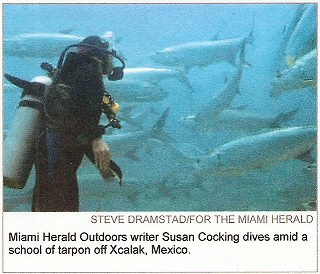MIAMI HERALD | SUSAN COCKING
Diving Haven Exists in Mexico
XCALAK, Mexico — Warning: Avid tarpon anglers, don’t even think about using sinking fly lines, live mullet, or a Lefty Deceiver. These tarpon are for viewing only – not for catching.
About 100 of them were lazing around, spa-like, about 60 feet deep in a coral-lined canyon less than a mile off this tiny town on the southern tip of the Yucatan Peninsula when I visited last summer.
The canyon is part of a marine sanctuary implemented about two years ago for the lands and nearshore waters of Xcalak, a Mayan word that means “two together,” named for two natural cuts through the barrier reef. The spot frequented by the tranquil tarpon is called La Poza, or freshwater spring — a place they go to chill out and have their gills cleaned by gobis and remoras.
“I’ve never seen them chase anything around. They’re just hanging out,” said Americanborn dive instructor Steve Dramstad, who has lived in Xcalak for more than three years.
Dramstad has explored reefs, walls, and underwater caves all over, but he remains in Xcalak (population 200) because it is still a frontier. Only two dive operations, XTC and Costa de Cocos — where Dramstad works – conduct underwater tours in the area.
“You almost never see anybody in the water — just small boats and small groups,” he said.
Xcalak’s marine sanctuary runs 18 miles north and seven miles south to the Belize border, where it adjoins that country’s existing reserve. Commercial fishing is prohibited, and only locals can freedive for lobster and conch. The result is peaceful, pristine diving.
Dramstad and I dropped down into a canyon bordered by a steep, colorful coral reef shoreward and a gradually sloping reef seaward. At first, we saw the usual reef denizens: bar jacks, chubs and some small mutton snappers. But emerging from a limestone swim through, we were surrounded suddenly by a school of about 100 tarpon. They ranged in size from a couple feet to more than six feet long. When Dramstad photographed them, the flash lit them up like huge slabs of bright aluminum siding. The tarpon aren’t the only visitors to “take the waters” at La Poza. Dramstad has seen a manatee snoozing on the bottom, and once was visited by a whale shark.
Another nearby dive site, La Chimenea, Spanish for “chimney,” is a hauntingly beautiful limestone cavern 87 feet deep, with two natural chutes to the surface.
Rounding the large boulders in semi-darkness, we encountered a school of juvenile glassy sweepers illuminated in violet by a diver’s light. Outside the cavern, we passed a large green moray eel flexing its open jaws; a vivid mocha-swirled Nassau grouper; and a four foot spotted eagle ray being trailed by a remora.
And the fishing isn’t too shabby either. Although you cannot target the tarpon at La Poza, there are miles of nearly deserted channels, creeks and flats in nearby Chetumal Bay, where the silver-scaled jumpers abound.
Not to mention Permit and Bonefish.
Escaping to a Caribbean jungle definitely has its rewards.
Outdoors writer Susan Cocking
